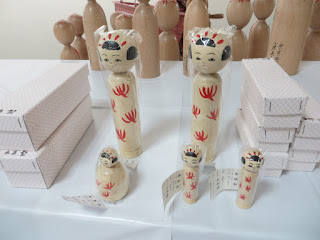Following my little jaunt around Zao (as described in the previous blog entry) we grabbed some breakfast items at a convenience store, checked out of the hotel, and headed down the mountain to Nana Beans in beautiful Yamagata City. Yes, "Nana Beans," the name of the building where the Yamagata Kokeshi Kan (museum) is located and where the Michinoku Kokeshi Festival みちのくこけしまつり is held every year.
 |
| The poster for the kokeshi festival. |
After arriving in the city we easily found parking across the street from Nana Beans and anxiously headed over the festival that had started perhaps an hour earlier. As we entered the building we found a hand-written sign saying the the kokeshi festival was on the 5th floor. So far so good.
 |
| Translated literally: "Kokeshi Festival is 5th Floor." |
When we got to the 5th floor there was a human-sized kokeshi painting on the wall saying that the Yamagata Traditional Kokeshi Kan やまがた伝統こけし館 was also to the right. We took a quick look on our way out of the festival, so I'll talk about that in another blog.
There was no fee for the festival, but you could buy a program and other kokeshi-related pamphlets, books and posters. I don't recall if we bought any paper items. Maybe so, but our main goal was of course to find some good kokeshis.
 |
| The reception desk selling pamphlets, books, and posters. |
The reception desk was on the left as we entered the hall, and to our right was a display of the different kokeshi families and a map of where they come from. They put this up every year and it's really well done. In fact if ever do a kokeshi show of some sort perhaps I'll set up a similar display. Behind that were long rows of kokeshis. The ones that were for sale were in the center and arranged by type while the competition winners along the left wall. The competition is a big part of these annual festivals for the collectors since they get to see the best that the craftsmen have produced. I have also learned recently that if a craftsman wins the Prime Minister's prize three times at one of the three major competitions -- Yamagata (Michinoku), Naruko, and Shiroishi -- he or she becomes a
meijin 名人.
Meijin here translates as "master" or "expert," which is apparently not only an important recognition in the kokeshi world, but also means that that craftsman is authorized to make an original kokeshi. I would like to learn more about this.
 |
| The display showing all the types and where they come from. |
Getting back to the festival, Naoko and the girls immediately grabbed a shopping basket and started looking for pieces to add to our collection. Judging by the number of people already milling around the hall, this year's event was very well attended. In fact the table with Mr. Abe Shin'ya's 阿部進矢さん kokeshis (one of Naoko's favorites) was already completely sold out when we arrived!
 |
| A view looking into the hall. Note the shopping basket that fellow is holding on the left. We saw some people who had filled their basket to the brim. |
 |
| Here's a shot looking back the other way. As this photo shows the hall was quite large and already crowded when we were there. |
There was plenty to see at the Michinoku Kokeshi Festival, and once you made it all the way to the back you could also talk with the five craftsmen who had been invited to the festival. And by all means chat with them -- they love to meet the people who buy their work. Here are some photos of that important part of the event.
 |
| The Craftsmen's Corner. |
 |
| Mr. Abe Kunitoshi 阿部国敏, a Tsuchiyu craftsman famous for his smiley, bobble-headed kokeshis. |
 |
| Mr. Abe's regular Tsuchiyu kokeshis. |
 |
| Mr. Abe's famous smiley kokeshis. Our girls got the red and blue ones on the center right of the photo. |
 |
| Naoko chatting with Mr. Onuma Hideaki 大沼秀顯さん of Naruko Onsen. |
 |
| Mr. Sasamori Jun'ichi 笹森淳一さん, a Tsugaru craftsman from Hirosaki City in Aomori Prefecture. |
 |
| Togatta craftsman Mr. Ogasawara Yoshio 小笠原義雄さん from Sendai City. It might be hard to see but Naoko got me the kokeshi head (actually a hollow bowl and cap) located a little bit left of center. Really a beautiful piece of craftsmanship. |
 |
| Mr. Sugawara Osamu 菅原修さん, a Naruko craftsman from Akita Prefecture. His work is very distinctive and pleasant but also hard to find, so we bought one. |
 |
| Mr. Sugawara's kokeshis. |
For expediency's sake I've posted a series of photos showing some of what was available for sale at this year's festival. As you can see there was a tremendous variety, but at the same time the pieces were moving very quickly because there were so many people in attendance.
After picking out all the kokeshis we wanted to add to our collection we had to pay for them. So Naoko lined up with her shopping basket and took care of that. Note for non-Japanese attending this and other big festivals: You will receive a ticket from the craftsman for the kokeshis you would like to buy, and then after paying at the cashier you bring the receipt to the craftsman who will then give you your purchase. As for the kokeshis sitting on the tables, those you put directly in your basket and pay for them directly at the cashier.
I've shown a lot here, but not everything. In the next blog I'll upload more photos and details of what we saw at the 2014 Michinoku Kokeshi Festival.







































































